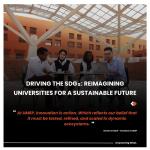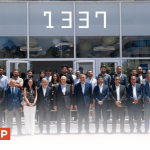Redesign Mining: Khouribga’s Model to Outsmart Fragile Logistics
“We stopped following fixed recipes. Now the model thinks like a master chef,” says Bassma Azzamouri, Assistant Professor at UM6P’s Geology and Sustainable Mining Institute. In Khouribga, Her model doesn’t just plan; it adapts, and negotiates trade-offs. It’s a radical shift: from fixed flows to dynamic supply chains.
Khouribga is not the kind of place that typically and naturally commands attention. Yet 120 kilometers southeast of Casablanca, in a city best known for its phosphate deposits and sunburnt terrain, a subtle transformation is underway.
This transformation doesn’t involve new machines, new factories, or futuristic tech parks. At least not yet. The infrastructure is familiar. The product – phosphate rock, vital for global agriculture – is anything but new.
And yet, the operations here are being transformed in ways that could redefine industrial logistics not only across Africa but in global sectors that still depend on fragile, rigid supply chains.
For decades, mining supply chains operated on deterministic models: flows were predefined, recipes rigid, and deviations addressed retroactively. Complexity was managed through oversimplification, not sophistication. At Khouribga, which contains one of the world’s largest phosphate reserves, the supply chain needed to be improved.
At the core of this quiet revolution is the “integrated steering model”, a dynamic planning model led by researcher Bassma Azzamouri, Assistant Professor at UM6P’s Geology and Sustainable Mining Institute, and developed, tested and validated over one and a half years.
“We moved from fixed recipes to flexible and dynamic, with full knowledge of the infrastructure, customer requirements, and resource state,” says Azzamouri. “It’s not just optimization. It’s about a knowledge-based approach.”
The team’s work is grounded in a Mixed Integer Linear Programming (MILP) model. But here, the optimization model is tailored for mining, taking into account not just what to produce, but how, when, and from what, in light of real-world physical constraints and volatile input quality.
A Modular System Built for Adaptation
What makes this approach noteworthy is that it uses mathematical formulations to plan production and to replace rigid production rules with adaptable logic.
In the traditional model, if a customer order required a blend of three raw phosphates—let’s say 40% from Mine A, 30% from Mine B, and 30% from washed output C—those proportions were fixed, often defined years prior. If any ingredient wasn’t available in the necessary quality or volume, the chain stalled. Delays ensued. Costs surged.
In the redesigned system, volumes are treated as decision variables, not fixed parameters. The model runs permutations—guided mainly by customer requirements, availability of raw materials and equipment capacity—and produces a production plan that changes week to week, sometimes day to day all depending on the need.
“It’s the difference between following a recipe and having a chef who can cook with whatever’s in the fridge,” Bassma explains.
Take one example from the study. Order 1, destined for international export, had a strict chemical profile: BPL between 65–66%, SiO₂ between 2.2–3.9%, Cd below 25 ppm. Using traditional methods, fulfilling this would require drawing down rare high-grade ores (HTM, THT) that are increasingly expensive and environmentally sensitive to extract.
Using the MILP model, the team produced a viable blend using more abundant, mid-quality ores—achieving target specs while cutting enrichment needs by 17% and reducing cost per ton.
The optimization is the tactic
This isn’t just an academic exercise. The model was deployed using live data: 88 distinct raw material streams, 4 chemical properties (BPL, SiO₂, MgO, Cd), multiple transportation paths, and time-sensitive delivery windows. It ran on a server with 12 vCPUs and 64 GB RAM, solving complex constraints in under 30 minutes per planning horizon.
But the real innovation isn’t speed. It’s alignment—horizontal and vertical.
Horizontally, the model links all nodes: extraction, washing, blending, and loading. A delay in a washing unit automatically adjusts the blending plan downstream. A shortfall in raw material from Mine 4 triggers alternate routing for available stocks from Mine 2—if quality tolerances allow. No manual recalculation required.
Vertically, it aligns strategic goals (minimize cost, conserve water, meet client specs) with tactical and operational decisions. Each part of the objective function is weighted, so supply chain managers can shift emphasis—maximizing quality in one cycle, minimizing production cost in another, or prioritizing the use of existing stock to free up storage space.
“When we adjust the model’s penalties, we’re effectively adjusting the company’s priorities,” says Azzamouri. “You’re not just getting a schedule. You’re getting a tactical signal.”
Why does this matter, now?
Industries across the world are recognizing that static planning no longer works. In energy, power grids must adjust to variable renewables. In agribusinesses, blending facilities respond to seasonal nutrient imbalances and erratic supply. In logistics, disruptions are the new normal.
Africa, especially, faces acute pressure: fast-growing markets, underdeveloped infrastructure, and high exposure to external shocks. But it also has a unique advantage—a blank slate for building optimizing systems from the ground up.
Khouribga’s redesign offers a template. It demonstrates that even in a legacy sector with entrenched workflows, it’s possible to improve the supply chain fabric. Not through flashy tech or massive capital expenditure, but by rewiring the logic of decision-making.
“Our infrastructure didn’t change,” Azzamouri notes. “But our way of making decision did. And that changed everything.”
From mines to models, and beyond
The implications are vast. Fertilizer factories in Ethiopia could use similar logic to dynamically adjust NPK blends. Logistics hubs in Kenya might reroute cargo in response to real-time port delays or rail constraints. Power plants could manage energy inputs in adaptive cycles.
Even within mining, the model is adaptable. Copper, bauxite, cobalt—any mineral with complex processing and volatile inputs could benefit.
A final note on sustainability: phosphate-rich ores like HTM and THT are scarce and ecologically expensive. The model allows supply chain planners to set “scarcity penalties,” preserving these inputs for essential use while fulfilling routine orders from blended mid-grade sources. That’s not just optimized supply chain. It’s resource diplomacy.
_1.png)



